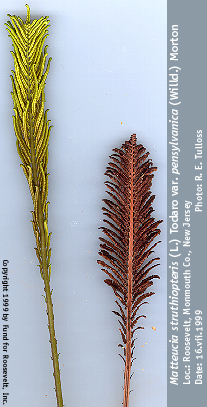|
Hardy Fern Home Matteuccia resources
All Ferns � Woodsiaceae �� Matteuccia
�Other Genera
|
| Matteuccia Earlier placement: | ||
Ostrich fern | ||
|
Etymology
Named after Carlo Matteucci (1811-1863), a physicist at the University of Florence, Italy and later a politician.
Description
Rhizome: erect, forming a vase-like plant, leaf-scales on the runners.
Frond: deciduous, dimorphic. Stipe: green, expanded base (trophopod), white hairs, vascular bundles: 2, lunate. Blade: sterile: 1-pinnate-pinnatifid, elliptic, sterile: herbaceous, absent or deciduously hairy below. Pinnae: proximal pinnae (several pairs) greatly reduced, sessile, costae shallowly grooved above, grooves not continuous from rachis to costae, segments entire, veins free. Sori: round, covered by revolute margins, indusium: vestigial, sporangia: green.
Distinctive Characteristics
The vase shape on a large plant and the ostrich feather outline of the sterile blade are enough to spot this. The persistent -- into the next year -- fertile fronds, when produced, are confirmatory. Older habitats are always composed of multiple plants produced stoloniferously.
|
|
|
